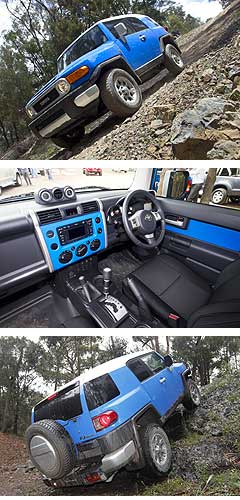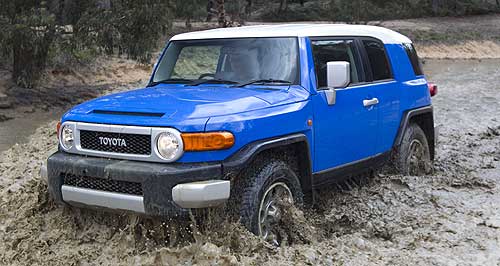Make / Model Search
Future models - Toyota - FJ CruiserToyota's upcoming FJ Cruiser to cost less than $50KSon of Prado: First right-hand drive Australian-sped FJ Cruiser hits the bush outside Canberra on the weekend. Toyota provides first local sample of retro FJ Cruiser 4WD ahead of March 2011 debut16 Nov 2010 TOYOTA’S niche FJ Cruiser off-roader is expected to go on sale for less than $50,000 when it arrives in showrooms around March 2011. The Prado-based retro wagon will join the equally odd-looking Rukus compact wagon as Toyota's second 'brand-building' model to be introduced in Australia in 12 months. Pricing for FJ is yet to be confirmed but Toyota Australia senior executive director of sales and marketing, David Buttner, said it would be priced very competitively and that to be competitive it would need to sit between $36,000 and $50,000. We expect the single-specification FJ to be closer to the top end of those numbers as it is a well-equipped and capable 4x4. The retro body harks back to the original FJ40 LandCruiser with its round headlights, grille design with ‘TOYOTA’ grille badge and its white-painted roof, but the FJ Cruiser is a modern vehicle and promises to deliver real-world performance and ability that the old FJ40 never could match. Its styling will not be for everyone, yet its uniqueness will appeal to just as many who are looking to stand out from the crowd of SUVs. Using a short-wheelbase version of Prado’s body-on-chassis platform, the FJ has a live rear axle with coil springs and twin-tube dampers, while at the front-end there an independent set-up with double wishbones and coil springs, just like both the short- and long-wheelbase Prados. It also uses the Prado’s 4.0-litre petrol V6 engine, delivering 200kW of power and 380Nm of torque, backed by the same five-speed automatic transmission. But where the Prado’s driveline offers permanent four-wheel drive, the FJ uses part-time 4x4, meaning it runs in two-wheel drive for most of the time, with 4x4 used mainly in off-road conditions. The FJ is no off-road pretender with its short front and rear overhangs and high ride height giving it the clearance it needs to tackle tough tracks, while a low-range transfer case and standard rear diff lock plus electronic traction control give it the tractive ability for steep terrain.  To ensure maximum ground clearance, Australian-specification FJs will not be fitted as standard with side steps, but these will be available as a genuine accessory if desired. To ensure maximum ground clearance, Australian-specification FJs will not be fitted as standard with side steps, but these will be available as a genuine accessory if desired.A range of locally developed accessories will be available from launch, but there will be no factory options for the single specification. Until now, the FJ Cruiser has been a US-only vehicle since its launch there in 2006 and the popular model has recently undergone a mild facelift there. Toyota Australia was waiting for this update before bringing the FJ to our shores. The update brings new 17-inch wheels, new bumpers and some interior trim and spec upgrades. The Australian vehicles have different rear bumper to US models with the licence plate in the centre rather than under the tailgate door-handle. The first local-spec FJ Cruiser was shown to journalists at a special event at the Toyota LandCruiser Club of Australia’s driver training facility in NSW last weekend. No drive was permitted due to the vehicle being the only one of its kind in Australia, although the FJ’s ability was demonstrated in the hands of rally driver Neil Bates. It took on the mild-grade bush tracks with ease. The Aussie-spec vehicle has a vinyl ‘hose out’ floor covering and the cloth seat trims include a special waterproofing material. The form-follows-function feel continues with body-coloured painted surfaces on the door panels and dash to simulate the painted metal interior panels of the original 1960s FJs. From the passenger’s seat, the upright and low windscreen offers a pillbox view of what is going on ahead of you with good over-bonnet visibility. The massive C-pillars and rear door-mounted spare wheel restrict rearward vision from inside, however, tall exterior mirrors make up for this while a reversing camera is standard and its image is displayed on the interior rear-view mirror. The ride felt soft, which is as you would expect of the Prado-based suspension design. The suspension was calibrated locally by Toyota Australia and is considerably different to the US suspension tune and better suited to local conditions and Australian drivers’ tastes. Stability and traction control are standard, as are ABS brakes and hill decent control. The dash in front of the passenger offers a huge plastic panel with the glovebox swinging down from below it. The audio system is the same as that found in the high-grade SR5 HiLux utility and features CD, AM/FM, USB and a 3.5mm input, plus Bluetooth phone connectivity. Driver and passenger airbags are fitted at the front, along with side and curtain airbags. The FJ Cruiser looks like a two-door but it has short rear doors that are hinged from the rear and open from inside the vehicle when the front doors are open. These give access to a rear seat that offers enough leg and shoulder room for three adults. The cargo area is not as big as a five-door Prado's but not as small as the three-door's. It is adequate for weekend trips away but not extended expeditions. Such expeditions would also be limited by the paltry 70-litre fuel tank and the range it gives the V6 petrol engine. As a US-designed vehicle, the FJ is built only with a V6 engine. Toyota Australia says it did look at fitting the Prado’s 3.0-litre turbo-diesel but could not make the numbers add up for a unique Australian application. The Prado diesel currently opens at $55,990 in both three and five-door guises, while the five-door petrol Prado is priced from $60,904. The FJ Cruiser is made in Japan at the Hino truck plant and now that it is made in right-hand drive, it will also go on sale in its home market. Two of the most popular colours on FJ Cruiser in America since it launched there have been Voodoo Blue, as seen on the car here, and Sun Fusion Yellow. These colours were discontinued with the latest facelift but Toyota Australia has been able to secure a limited run of Australian-spec FJs in these colours from the first few months of production. They will disappear from the palette soon after and the available colours will include silver, black, cherry and white. All FJs have a white roof regardless of body colour. As a true niche model, the FJ will not be a huge seller here and Toyota could not give a prediction of how many it expects to sell. But if it does land at less than $50,000 the FJ should be popular with Australians, with buyers expected to come from two different groups – those who want the unique, retro style of the FJ and those who want its off-road ability.  Read moreAll future models Alfa Romeo Alfa Romeo Abarth Abarth Alpine Alpine Alpina Alpina Audi Audi Aston Martin Aston Martin BMW BMW Bentley Bentley Chery Chery Brabham Brabham Chrysler Chrysler Chevrolet Chevrolet Cupra Cupra Citroen Citroen DS DS Dodge Dodge Fiat Fiat Ferrari Ferrari Foton Foton Ford Ford Great Wall Great Wall FPV FPV Haval Haval GWM GWM Honda Honda Holden Holden Hummer Hummer HSV HSV Infiniti Infiniti Hyundai Hyundai Jaguar Jaguar Isuzu Isuzu Kia Kia Jeep Jeep Land Rover Land Rover Lamborghini Lamborghini Lexus Lexus LDV LDV Mahindra Mahindra Lotus Lotus Mazda Mazda Maserati Maserati Mercedes-AMG Mercedes-AMG McLaren McLaren MG MG Mercedes-Benz Mercedes-Benz Mitsubishi Mitsubishi Mini Mini Opel Opel Nissan Nissan Peugeot Peugeot Pagani Pagani Proton Proton Porsche Porsche Renault Renault Ram Ram Rover Rover Rolls-Royce Rolls-Royce Skoda Skoda Saab Saab SsangYong SsangYong Smart Smart Suzuki Suzuki Subaru Subaru Toyota Toyota Tesla Tesla Volvo VolvoMotor industry news |
Click to shareToyota modelsResearch Toyota All future models Alfa Romeo Alfa Romeo Abarth Abarth Alpine Alpine Alpina Alpina Audi Audi Aston Martin Aston Martin BMW BMW Bentley Bentley Chery Chery Brabham Brabham Chrysler Chrysler Chevrolet Chevrolet Cupra Cupra Citroen Citroen DS DS Dodge Dodge Fiat Fiat Ferrari Ferrari Foton Foton Ford Ford Great Wall Great Wall FPV FPV Haval Haval GWM GWM Honda Honda Holden Holden Hummer Hummer HSV HSV Infiniti Infiniti Hyundai Hyundai Jaguar Jaguar Isuzu Isuzu Kia Kia Jeep Jeep Land Rover Land Rover Lamborghini Lamborghini Lexus Lexus LDV LDV Mahindra Mahindra Lotus Lotus Mazda Mazda Maserati Maserati Mercedes-AMG Mercedes-AMG McLaren McLaren MG MG Mercedes-Benz Mercedes-Benz Mitsubishi Mitsubishi Mini Mini Opel Opel Nissan Nissan Peugeot Peugeot Pagani Pagani Proton Proton Porsche Porsche Renault Renault Ram Ram Rover Rover Rolls-Royce Rolls-Royce Skoda Skoda Saab Saab SsangYong SsangYong Smart Smart Suzuki Suzuki Subaru Subaru Toyota Toyota Tesla Tesla Volvo VolvoMotor industry news |











Facebook Twitter Instagram